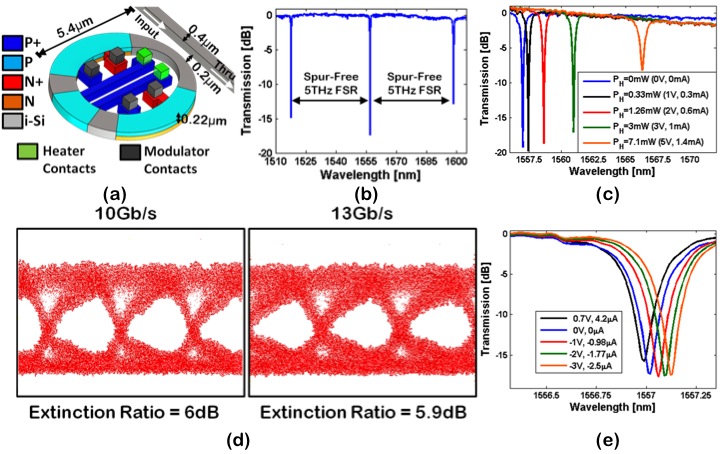Adiabatic Resonant Microring Modulators with Integrated Thermal Tuner
- Category: Nanotechnology, Optics & Photonics
- Tags: erman timurdogan, michael watts
Wavelength division multiplexed systems can achieve high bandwidth by utilizing many channels on a single fiber as opposed to current single channel per cable or fiber interconnects. Silicon photonics can readily enable wavelength-division multiplexed (WDM) systems through the use of compact, inherently wavelength selective micro-ring/-disk resonators. Such devices have been demonstrated to have energies as low as 3fJ/bit at a data rate of 12.5Gb/s[1] and 13fJ/bit at a data rate of 25Gb/s[2]. However, resonance drifts, induced by process/wafer variations and dynamic temperature fluctuations, detune the alignment between the modulators and the WDM lasers and need to be compensated. Electro-optic tuning can compensate only for temperature variations of ~± 2.50C, while processor core activity on chip yields temperature fluctuations on the order of ±100C. Therefore, thermo-optic tuning and control of resonators is required[3].
Here[4], we demonstrate a 5.4-µm-diameter adiabatic resonant microring (ARM) modulator with a CMOS compatible integrated heater (Figure 1a) allowing for single mode operation (Figure 1b), high performance modulation and minimum thermal capacitance. High-speed modulation (Figure 1d) is achieved through a vertical p-n junction around the edge of the ARM modulator and low resistance interior contacts. Electro-optic frequency shifts and spectral response are shown in Figure 1e. The proposed ARM modulator is measured to have a 6.2µW/GHz thermal tuning efficiency (Figure 1c), ~9fJ/bit modulation performance at a data rate of 13Gb/s (Figure 1d), and a 5.9dB extinction ratio. This is the first demonstration of an integrated heater and modulator within an ARM resonator and the most compact microring modulator with a directly integrated heater.

Figure 1: a) 3D sketch of the ARM modulator with integrated heater showing size, doping and contacts. b) Spur-free single mode operation of the LRM modulator with a FSR of 5 THz. c) Measured DC spectral response of the integrated heater inside the ARM modulator with an applied bias voltage to heater pins. d) High-speed optical eye diagrams at a data rate of 10- and 13-Gb/s with a 1.8Vpp (0 to -1.8V) drive. The extinction ratio is 6dB. e) Measured spectral response of the ARM modulator with applied DC bias voltage to modulator pins from -3V to 0.7V.
- M. R. Watts, W. A. Zortman, D. C. Trotter, R. W. Young, and A. L. Lentine, “Vertical junction silicon microdisk modulators and switches,” Opt. Exp., vol. 19, no. 22, pp. 21989–22003 2011. [↩]
- E. Timurdogan, C. M. Sorace-Agaskar, A. Biberman, and M. R. Watts, “Vertical Junction Silicon Microdisk Modulators at 25Gb/s,” in Proc. OFC/NFOEC, paper OTh3H.2 2013. [↩]
- E. Timurdogan, A. Biberman, D. Trotter, C. Sun, M. Moresco, V. Stojanovic, and M. R. Watts, “Automated Wavelength Recovery for Microring Resonators,” in Proc. Conf. Lasers Electro-Opt., paper CM2M.1 2012. [↩]
- E. Timurdogan, C. M. Sorace-Agaskar, G. Leake, D. D. Coolbaugh, and M. R. Watts, “Adiabatic Resonant Microring (ARM) Modulators with Integrated Thermal Tuner,” in Proc. Advanced Photonic Congress, paper IT5A.7 2013. [↩]